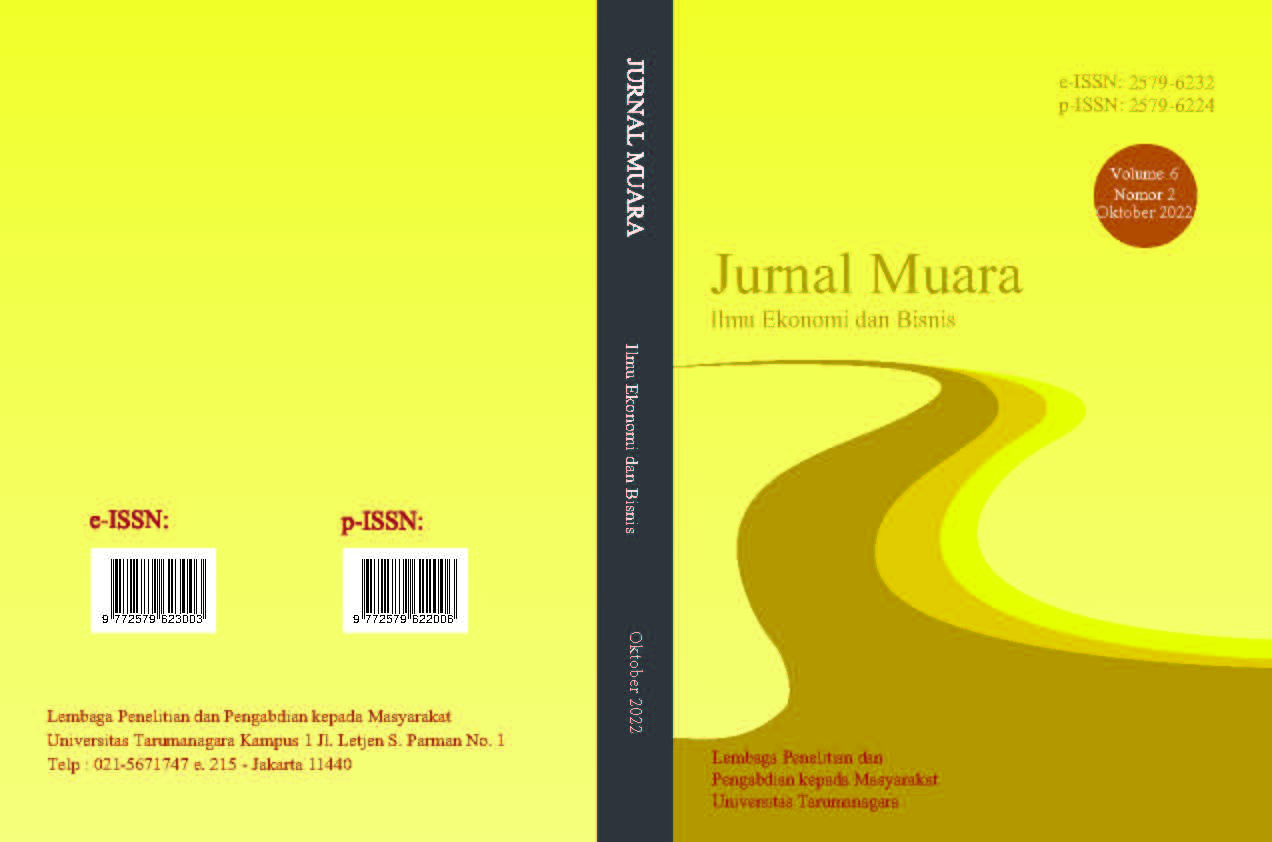EKUITAS MEREK HOTEL BERBINTANG DI JAKARTA: PERAN KESADARAN MEREK, ASOSIASI MEREK, PERSEPSI KUALITAS DAN LOYALITAS MEREK
Main Article Content
Abstract
Penelitian ini mengkaji peran asosiasi merek, kesadaran merek, loyalitas merek dan persepsi kualitas untuk membangun ekuitas merek pada industri perhotelan di Jakarta. Sebagaimana diketahui, ekuitas merek merupakan keunggulan kompetitif dan aset strategis bagi perusahaan dalam jangka panjang. Oleh karenanya pemasar memberikan perhatian pada isu terkait ekuitas merek. Populasi yang diteliti adalah pelanggan hotel di Jakarta. Metode pemilihan sampel yang digunakan adalah nonprobabilitas berupa convenience sampling. Ukuran sampel sebesar 100 responden di Jakarta yang merupakan pelanggan hotel minimal berbintang tiga yang memiliki frekuensi menginap minimal sekali dalam setahun. Data dianalisis dengan Partial Least Square Structural Equation Modelling (PLS SEM) dengan bantuan program statistik SmartPLS. Hasil analisis memperlihatkan bahwa asosiasi merek, persepsi kualitas dan loyalitas pelanggan memiliki peran secara positif dan signifikan terhadap ekuitas merek, sementara kesadaran merek berperan positif namun tidak signifikan. Hasil penelitian ini diharapkan dapat memberikan manfaat bagi pemasar hotel berbintang tiga, empat dan lima untuk membangun ekuitas merek berbasis pada asosiasi, kesadaran dan loyalitas pelanggan terhadap merek.
This study aims to analyze the role of brand association, brand awareness, brand loyalty and perceived quality to build brand equity in the hotel industry in Jakarta. As is known, brand equity is a competitive advantage and strategic asset for a company in the long run. Therefore, marketers pay attention to issues related to brand equity. The population is hotel customers in Jakarta. The sample selection method used is non-probability with convenience sampling technique. The sample size is 100 respondents in Jakarta who are customers of at least three-star hotels who have a frequency of staying at least once a year. The data analysis technique used was Partial Least Square Structural Equation Modeling (PLS SEM) by using SmartPLS statistical program. This study showed that perceived quality, brand associations and customer loyalty have a positive and significant role on brand equity, while brand awareness has a positive but not significant role. This study is expected to assist marketers of three, four and five star hotels to build brand equity based on association, awareness and customer loyalty.
Article Details
Section

This work is licensed under a Creative Commons Attribution-NonCommercial-ShareAlike 4.0 International License.
This work is licensed under a Jurnal Muara Ilmu Ekonomi dan Bisnis Creative Commons Attribution-ShareAlike 4.0 International License.References
Aaker, D (1991). Managing Brand Equity: Capitalizing on The Value of a Brand Name. The Free Press: New York.
Agnes & Darmawan. (2020). Brand Awareness, Brand Image dan Brand Loyalty Sebagai Prediktor Brand Equity Adidas, Jurnal Manajerial dan Kewirausahaan, Vol 2 No. 1, Hal: 240-250.
Altaf, M., Tabassum, N. and Mokhtar, S.S.M. (2018). Brand equity and the role of emergency medical care service quality of private cardiac institutes: An empirical investigation, International Journal of Pharmaceutical and Healthcare Marketing, Vol. 12 No. 1, pp. 44-60. https://doi.org/10.1108/IJPHM-09-2016-0046.
Bougie, R., Sekaran, U (2020). Research Method for Business, A Skill Building Approach, 8th Edition, Wiley.
Brochado, A. and Oliveira, F. (2018). Brand equity in the Portuguese vinho verde “green wine” market, International Journal of Wine Business Research, Vol. 30 No. 1, pp. 2-18.
Dekimpe, M.G., Mellens, M., Steenkamp, JB E.M., Abeele, P.V., (1997). Erosion and variability in brand loyalty, https://www.researchgate.net/publication/46429593.
El-Adly, M.I. and Abu ELSamen, A. (2018). Guest-based hotel equity: scale development and validation, Journal of Product & Brand Management, Vol. 27 No. 6, pp. 615-633.
Gil, R.B., Andrés, E.F. and Salinas, E.M. (2007). Family as a source of consumer-based brand equity, Journal of Product and Brand Management, Vol. 16 No. 3, pp. 188-199.
Kayaman, R. and Arasli, H. (2007). Customer based brand equity: evidence from the hotel industry, Managing Service Quality: An International Journal, Vol. 17 No. 1, pp. 92-109.
Kim, H., Gon Kim, W. and An, J.A. (2008). The effect of consumer‐based brand equity on firms’ financial performance, Journal of Consumer Marketing, Vol. 20 No. 4, pp. 335-351. https://doi.org/10.1108/07363760310483694.
Kimpakorn, N., Tocquer, G. (2010). Service brand equity & employee brand commitment, Journal of Service Marketing, DOI: 10.1108/08876041011060485.
Kotler, P., Keller, K.L., (2012). Marketing Management, 14th Edition, Upper Saddle River: New Jersey.
Mowen, J.C., Minor, M (2002). Perilaku Konsumen (Jilid 1), Edisi Kelima, Jakarta: Erlangga.
Oliver, Richard L (1997). Satisfaction: A Behavioral Perspective on the Consumer, New York, NY: McGraw-Hill.
Robinson, C., Abbott, J. and Shoemaker, S. (2005). Recreating cheers: an analysis of relationship marketing as an effective marketing technique for quick‐service restaurants, International Journal of Contemporary Hospitality Management, Vol. 17 No. 7, pp. 590-599. https://doi.org/10.1108/09596110510620663.
Sanyal, S.N., Datta, S.K. (2011). The effect of country origin on brand equity: an empirical study on generic drugs, Journal of Product & Brand Management, Vol. 20 No. 2 pp 130-140.
Sasmita, J. and Mohd Suki, N. (2015). Young consumers’ insights on brand equity: Effects of brand association, brand loyalty, brand awareness, and brand image, International Journal of Retail & Distribution Management, Vol. 43 No. 3, pp. 276-292.
Šerić, M. and Mikulić, J. (2020). Building brand equity through communication consistency in luxury hotels: an impact-asymmetry analysis, Journal of Hospitality and Tourism Insights, Vol. 3 No. 4, pp. 451-468. https://doi.org/10.1108/JHTI-11-2019-0119.
So, K.F., and King, C. (2010). When experience matters: building and measuring hotel brand equity: The customers' perspective, International Journal of Contemporary Hospitality Management, Vol. 22 No. 5, pp. 589-608. https://doi.org/10.1108/09596111011053765.
Tong, X. and Hawley, J.M. (2009). Measuring customer‐based brand equity: empirical evidence from the sportswear market in China, Journal of Product & Brand Management, Vol. 18 No. 4, pp. 262-271.
Tran, V.T., Nguyen, N.P., Tran, P.T.K., Tran, T.N. and Huynh, T.T.P. (2019). Brand equity in a tourism destination: a case study of domestic tourists in Hoi An city, Vietnam, Tourism Review, Vol. 74 No. 3, pp. 704-720. https://doi.org/10.1108/TR-08-2017-0130.
Yoo, B. and Donthu, N. (2002). Testing cross‐cultural invariance of the brand equity creation process, Journal of Product & Brand Management, Vol. 11 No. 6, pp. 380-398. https://doi.org/10.1108/10610420210445505.
Zeithaml, V.A. (1988) Consumer Perceptions of Price, Quality, and Value: A Means-End Model and Synthesis of Evidence, Journal of Marketing, 52, 2-22. http://dx.doi.org/10.2307/1251446.

